Association says nightclub has failed to adequately address noise issues
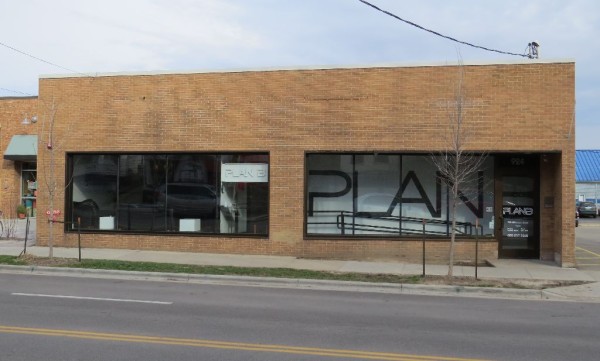 The Marquette Neighborhood Association voted this week to ask a City of Madison Committee to review the alcohol license of Plan B nightclub at 924 Williamson Street. In a letter approved by the MNA Board on Thursday, April 18, the association wants the City’s Alcohol Licensing Review Committee (ALRC) to separate Plan B’s license for closer scrutiny when the ALRC makes its yearly license renewals in June.
The Marquette Neighborhood Association voted this week to ask a City of Madison Committee to review the alcohol license of Plan B nightclub at 924 Williamson Street. In a letter approved by the MNA Board on Thursday, April 18, the association wants the City’s Alcohol Licensing Review Committee (ALRC) to separate Plan B’s license for closer scrutiny when the ALRC makes its yearly license renewals in June.
The battle over noise at Plan B has pitted a nightclub which appears to be in compliance with current noise ordinances against neighbors who nightly feel vibrations from the bass portion of the music being played at the club. The owners of Plan B say they have made good faith efforts and spent money to ameliorate the noise issues. The neighbors say that Plan B has only taken minimal steps to solve the problem and refuse to tackle the main culprit: a roof that is susceptible to vibration and is likely transmitting it toward the neighborhood one block away.
For the ALRC, separation, as it is known, occurs when issues arise around the operation of an establishment that holds an alcohol license and are not necessarily limited to the distribution of alcohol, but may also include security, noise, or criminal activity. In the case of Plan B, residents in the immediate area of the nightclub cite continued problems with noise and the lack of a resolution of those problems with the owners.
It’s not the first time there has been a request for Plan B’s license to be separated. Last year, District 6 Alder Marsha Rummel requested the Committee conduct an individual review after an impasse developed between neighbors and Plan B owners Rico Sabatini and Cory Gresen, who had been working for nearly three years on a solution. Additionally, a noise citation was issued by Madison Police in March 2012 after an officer observed noise from the rear second floor sun deck and inside the rear bedroom of 936 Jenifer Street, a single-family home.
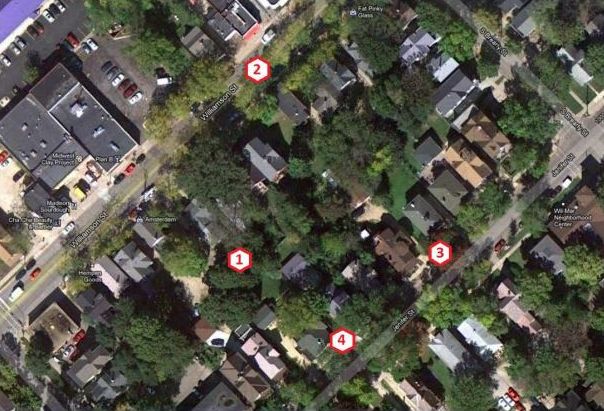
An overhead look at the affected block from the May 2012 sound study conducted by Acoustics By Design for Plan B to measure ordinance compliance. The numbers show where measurements were made. Plan B is to the left of the large parking lot on the upper left. The Guyot house is to the left of #3; to the left of # 4 is the Lee-Skaggs and Gallo house respectively. Source: City of Madison
At issue are bass transients that are emanating from the roof of the club and causing vibrations that are heard and felt in several homes on Jenifer Street, one block south of Williamson. While many residents in the area of Plan B have complained about noise and lost sleep; three families: Steve and Tracy Gallo, Lynn Lee and Steve Skaggs and Richard and Judith Guyot, who live on the 900 block of Jenifer, have been the most active in raising issues with Plan B.
Jenifer Street in that area runs along what is known as the Third Lake Ridge, which means that the roof of Plan B is at a lower elevation than the basement floors of all the homes on Jenifer Street, according to Richard Guyot, whose home the police officer observed the noise and issued the citation. Guyot says that the sound from the roof rolls up hill, enveloping many of the houses nearby even though the club is laterally aligned with 922 Jenifer Street.
Editor’s Note: In the interest of full disclosure; I currently live in one of the houses on Jenifer Street that is affected by the noise from Plan B and I am a relative of the family that lives in that house.Willy Street Blog reporting of this and other stories follow normal sourcing. Any purely opinion-based articles will be clearly labeled as such.
In a January 2012 letter to stakeholders in the dispute, an attorney representing Plan B’s owners cited a City of Madison memorandum regarding several unannounced visits in 2011 and argued that Plan B was in compliance and had made good faith efforts to address neighborhood issues:
“…the sound level of the music and bass coming from Plan B is not unreasonable and is certainly not excessive. From what I [City Attorney Jennifer Zilavy] observed, the owners have a very well-trained staff and are very conscientious of keeping their patrons in order.”
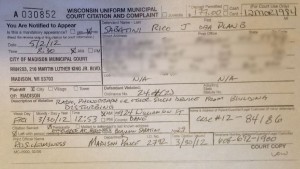
The noise citation issued in March 2012, the only one Plan B has incurred since its opening in 2009; and is currently being contested by Plan B.
A sound study commissioned by Plan B in 2011 came to that conclusion as well, stating that the sound pressure level, which is reported in decibels, registered in the 39 dBA to 42 dBA range when it reached the residences on Jenifer Street. However, the study also noted that the bass sound has an irritation factor that cannot be measured by SPL:
“While these levels are quite low, the problem arises due to the nature of the signal with its rhythmic bass. The human ear/brain combination easily distinguishes this signal from that of sustained background noise such as produced by the nearby HVAC fan.
The literature details extensive criteria for determining the irritation value of signals based upon such factors as SPL [sound pressure level], waveform, repetition rate, time of day, etc., so it is these additional factors, not just the SPL, that result in the complaints.”
In a 2012 interview with Willy Street Blog, Alder Marsha Rummel summed up the noise problem with Plan B’s roof, atop the building that previously housed Star Photo, a commercial photo processing business.
“The roof…it’s an old commercial building not that well insulated. It turns into a drum, and it vibrates, and the noise goes up the hill, and its effect is uneven, which is good; I’m glad it’s not affecting everybody, but it does affect several households.”
When Plan B’s license was separated by the ALRC last June, the Committee renewed the license but ordered Plan B to continue a dialogue with Alder Rummel, the neighbors, and Marquette Neighborhood Association (MNA) to address the noise complaints and report back to the ALRC.

FruitFest 2012, a Plan B event that has become a welcome part of the neighborhood culture. The 12-foot privacy wall can be seen on the right, built to deflect sound.
The MNA formed a committee in July 2012 that included board members, representatives from the three families involved in the dispute, the owners of Plan B, plus Chuck Chvala (who owns the building) and Mark Woulf, a non-voting member of the ALRC representing the Mayor’s Office.
The MNA committee has met twice since then, once in September 2012 and once last month. In October, Plan B installed interior sound proofing for the roof, including additional drywall and mineral wool.
Other improvements that Plan B has made over the last several years include bass traps, a bass audio limiter, privacy fencing for their parking lot, and modified a rear door along with a high wall around that entrance to direct sound north toward the rail corridor behind the club.
At the April 18 MNA meeting, Sabatini and Gresen expressed frustration about the letter, in light of all the money they had spent to address the noise and the fact that dialogue with the neighborhood was still proceeding.
“A separation is a big deal; it costs us a lot of money,” Sabatini said at the meeting.
Plan B did not respond to a request from Willy Street Blog for comment on the MNA letter or detailed information on the costs of the improvements that have already been done, which are estimated at $3,500 for the bass limiter and soundproofing. Plan B has not detailed publicly what they have spent on the other improvements, including security.
In an interview with Willy Street Blog last fall, after Gresen and Sabatini had met for the first time with the MNA Committee, they said they have had four independent sound studies performed on the premises over the years, two by private contractors and two by the city, and all were found to be within limits of the ordinance.

Plan B Co-Owner Cory Gresen.
A filing submitted by an attorney for the three families with the ALRC for the June 2012 separation hearing included a quote, requested by Plan B, showing the cost of an exterior roof sound proofing layer recommended by the 2011 sound study at approximately $12,000.
Plan B told the neighborhood at the September meeting that they were proceeding with interior sound proofing instead.
“We said this is our final step. We’re tearing down all the lights on the dance floor. We’re tearing down the ceiling. We’re putting in mineral wool – it’s a very thick-like fiberglass insulation. We’re gonna fill in the ceiling with that and drywall it and put the wood back up.”
Sabatini added that they asked homeowners at the meeting in September 2012 if they were to do the additional soundproofing when and if they go for their second-floor expansion, if they would support it.
“They were like ecstatic. There wasn’t a full yes,” Sabatini said. “But you know what, this is what we’re doing. There is nothing more that we can do other than move, and we’re not moving and neither are they, and they need to come to grips with it.”
On the surface, Plan B appears to be responsive, but many who were at the MNA board meeting have grown frustrated at the protracted nature of the problem. Steven Gallo, who lives in one of the homes on Jenifer that is affected almost nightly, says that Plan B is ignoring its own sound consultant, who recommended the club install a one-quarter inch layer of Mass Loaded Vinyl (MLV) to the northern two-thirds of the roof exterior, which is the portion directly over the dance floor.
Indeed, Plan B acknowledged that the roof is the likely culprit when it ordered the study in 2011. As noted in the consultant’s report:
“The problem that you described when engaging our services was music from the sound system at 924 Williamson Street being an irritation to neighbors, with complaints coming from residences one block to the south “on the north side of Jenifer Street. You further indicated your belief that the sound transmission was through the roof, as the shell of the building is mostly concrete masonry units, but the roof is wood framing with a rubber membrane.
The site visitation of 14 July 2011 confirmed that the roof is the basis of the problem…The good news is that, based upon the values determined, only a relatively small amount of attenuation will be needed to eliminate the problem.”
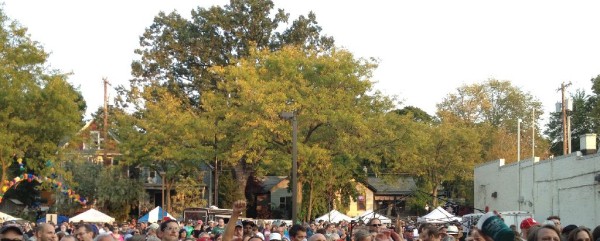
Bass transients that emanate from the roof can be heard and felt in houses on Jenifer Street which are beyond the trees in this photo. At least one resident that lives in a house seen in the background has complained about yelling and screaming late on Thursday nights as patrons leave the club.
The consultant goes on to recommend the MLV layer and an audio limiter, the latter of which Plan B did install. While Plan B is not against adding an MLV layer to the roof, they insist it should be part of a larger remodeling project the owners would like to do, which involves a second floor addition.
So far, neighbors have been leery about supporting an expansion until the original noise issues are resolved.
While the homeowners seemed encouraged last fall by the new effort by Plan B, in the intervening months they say the situation has not had a measurable improvement, which may have precipitated MNA’s action.
A resident who lives directly across from Plan B on Williamson said at the MNA board meeting on April 18 that yelling and screaming from patrons on Thursday nights as they leave the club wakes her family. Plan B also announced at the meeting that they had hired additional security and were working with Madison Police to address noise on Thursday nights, which is their 18 and over night at the club.
Ground Zero Coffee owner Lyndsey Lee also showed frustration with Plan B at the April 18 meeting, noting that when they first approached the neighborhood it was for a restaurant/bar/lounge at a Blount Street location (which has since been occupied by Google).
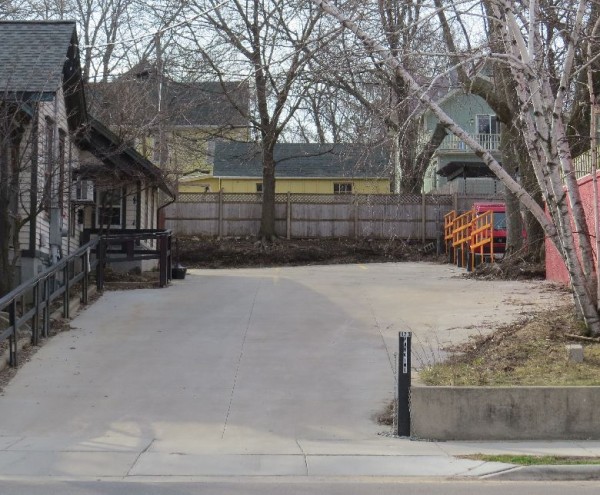
A view of the houses on Jenifer Street from the sidewalk in front of Plan B. The Lee-Skaggs house is the yellow one on the left, the Gallo house is on the right.
Lee said he wrote a letter of recommendation as a representative of the Greater Williamson Area Business Association in support of their project.
Lee went on to say that it was at the last minute, after the Blount Street location fell through, that Sabatini and Gresen switched the nature of their business to a nightclub at the current location.
Lee also added that the nightclub would have been more appropriate on Blount, and the restaurant would have fit the mixed-use nature of Willy Street.
“There were expectations, you agreed to those expectations, and you need to agree to pay the costs of those expectations,” Lee said, referencing the tribulations of his brother, Lynn, who lives in one of the affected houses on Jenifer.
Rico Sabatini said at the April 18 meeting that they did not misrepresent what they would do when they first proposed a nightclub at the location. “We are in compliance with the noise ordinance,” Gresen added. Those comments back up Sabatini’s contention in a Willy Street Blog interview last year that they were up front with the neighborhood when they brought the idea forward in 2008.
“We never described ourselves as being a mouse when we are an elephant. We accept it. We’re like, ‘Hey, we are a nightclub. There is gonna be some noise,’” Sabatini said. “We’re never gonna be silent like we’re not here. You need to also accept that fact.”
Looking back at the minutes of neighborhood meetings in 2008 when the nightclub was proposed, many of the concerns expressed then about the establishment being located in a mixed-use neighborhood have more or less been borne-out. A Madison Police official was quoted in a 2008 Capital Times article about the proposed nightclub, characterizing it as “ambitious”. Scott Thornton, who at the time was MNA Board president, was also quoted as having concerns.
“The issue will be that the block isn’t terribly commercial and that there are residences across the street and next door,” he told the Capital Times. “It’s a lot different than where they originally planned to go, which was very commercial and not residential at all.”
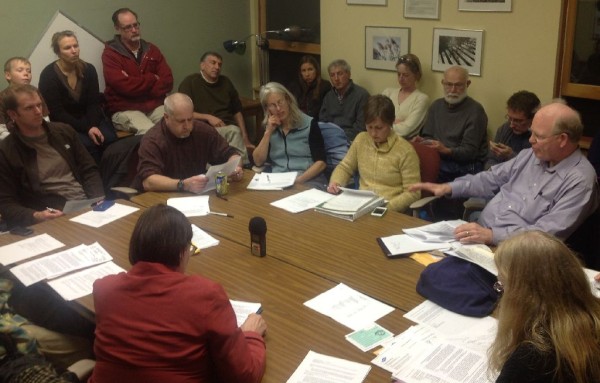
The MNA Board meets at the Wil-Mar Neighborhood Center on Thursday April 18, 2013. (L to R: Ralph Kuehn, President Michael Jacob, Anne Walker, Nicole Craig, Bill Scanlon, Treasurer Cheryl Solaris and Joan Frost (foreground). Not pictured but present: Carl Durocher, Tom Boos, Vice-President Chris Lukas and Secretary Mike Soref.
The neighbors don’t necessarily want to see Plan B go away. Through the various meetings with Sabatini and Gresen, they have offered to hold fundraisers to pay for roof improvements to save themselves “three years of misery,” as the three families involved in the dispute wrote in a letter to the ALRC in November 2012. The families also contend that a second independent sound study in 2012 only focused on the noise ordinance and not the bass issue which is at the heart of their complaints.
During discussion of the letter amongst the Board at the April 18 meeting, member Joan Frost, who also serves on the MNA committee working on the Plan B issue, told Sabatini and Gresen that addressing the sound issues properly is the cost of doing business.
“It’s the cost of doin’ business in this neighborhood, because these are your neighbors,” Frost said.
The MNA letter to the ALRC asks for separation of the license and “that full resolution of this protracted noise issue must be a condition for license renewal.”
Read the MNA letter to the ALRC here
Read the 2011 sound study here
Editor’s Note: Willy Street Blog received a copy of the Plan B commissioned study at the above link from one of the three families opposing the noise at Plan B. Thus it contains margin notes throughout the document that may appear prejudicial to some. Attempts to obtain a clean copy by the time of publication were unsuccessful.

